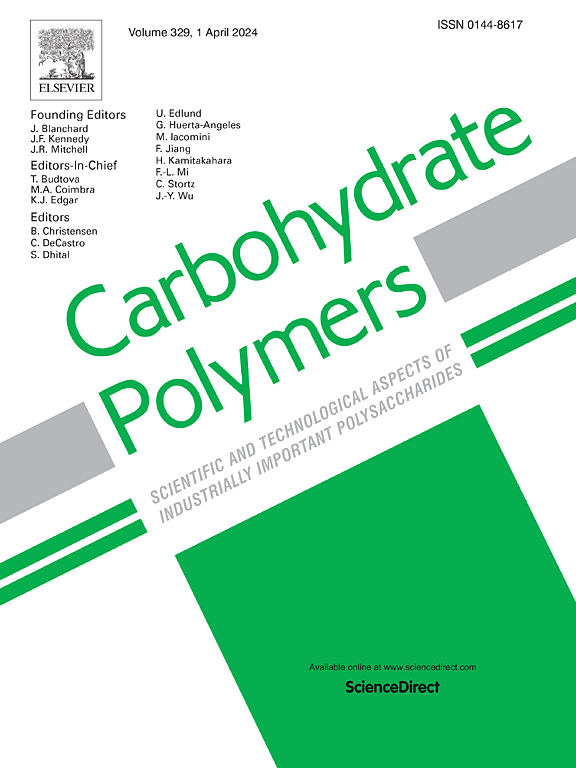改性羧甲基纤维素吸附剂对水中铅(II)和镉(II)的有效去除设计
IF 12.5
1区 化学
Q1 CHEMISTRY, APPLIED
引用次数: 0
摘要
本研究将羧甲基纤维素(CMC)与3-巯基丙基三甲氧基硅烷接枝,交联后冷冻干燥,制备具有三维网状结构的羧甲基纤维素基吸附剂。该吸附剂具有价格低廉、环保、稳定性高等优点,能有效去除废水中的铅离子(Pb (II))和镉离子(Cd (II))。对Pb (II)和Cd (II)的最大吸附量分别为322.96 mg/g和199.35 mg/g,在60 min内达到吸附平衡,吸附速度快,吸附效率高。在多种离子共存的情况下,吸附剂仍表现出较高的Pb (II)和Cd (II)吸附剂,表现出良好的离子选择性。吸附过程符合拟二级动力学模型和Langmuir吸附等温线,表明吸附过程以化学吸附为主。经过5次吸附-解吸循环试验,吸附剂仍保持较高的吸附效率和完整性,证明吸附剂具有良好的可回收性和可重复使用性。密度泛函理论计算表明,吸附后HOMO-LUMO间隙减小,表明通过与官能团的轨道杂化,电荷转移增强。本研究为制备低成本、环保、高效、可重复使用的有毒重金属离子吸附剂提供了新的思路。本文章由计算机程序翻译,如有差异,请以英文原文为准。

Design of modified carboxymethyl cellulose adsorbent for effective removal of Pb (II) and cd (II) from aqueous solutions
In this study, carboxymethyl cellulose (CMC) was grafted with 3-mercaptopropyl trimethoxy silane, crosslinked and then freeze-dried to fabricate the modified CMC-based adsorbent with three-dimensional network structure. The adsorbent showed the advantages of low price, environmental protection and high stability, and could effectively remove lead ion (Pb (II)) and cadmium ion (Cd (II)) from wastewater. The adsorption equilibrium for two metal ions could been achieved within 60 min with the maximum adsorption capacity of 322.96 mg/g and 199.35 mg/g for Pb (II) and Cd (II), indicating fast adsorption rate and high adsorption efficiency. Under the coexistence of multiple ions, the adsorbent still exhibit high Pb (II) and Cd (II) adsorption, demonstrating the good ion selectivity. Furthermore, the adsorption conformed to the pseudo-second-order kinetic model and Langmuir adsorption isotherm, indicating that the adsorption process was mainly chemical adsorption. After five adsorption-desorption cycle tests, the adsorbent still maintain high adsorption efficiency and integrity, proving the good recyclability and reusability. Density functional theory calculations revealed that the HOMO-LUMO gaps decreased after adsorption, implying the enhanced charge transfer via orbital hybridization with functional groups. This work provides a new idea for preparing low-cost, environmentally friendly, efficient, and reusable adsorbents to capture toxic heavy metal ions.
求助全文
通过发布文献求助,成功后即可免费获取论文全文。
去求助
来源期刊

Carbohydrate Polymers
化学-高分子科学
CiteScore
22.40
自引率
8.00%
发文量
1286
审稿时长
47 days
期刊介绍:
Carbohydrate Polymers stands as a prominent journal in the glycoscience field, dedicated to exploring and harnessing the potential of polysaccharides with applications spanning bioenergy, bioplastics, biomaterials, biorefining, chemistry, drug delivery, food, health, nanotechnology, packaging, paper, pharmaceuticals, medicine, oil recovery, textiles, tissue engineering, wood, and various aspects of glycoscience.
The journal emphasizes the central role of well-characterized carbohydrate polymers, highlighting their significance as the primary focus rather than a peripheral topic. Each paper must prominently feature at least one named carbohydrate polymer, evident in both citation and title, with a commitment to innovative research that advances scientific knowledge.
 求助内容:
求助内容: 应助结果提醒方式:
应助结果提醒方式:


